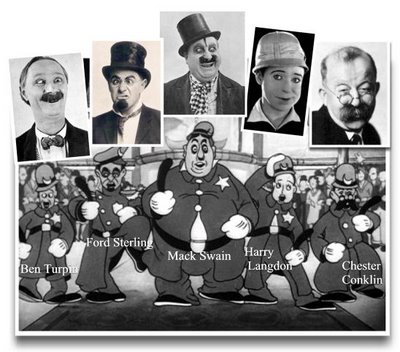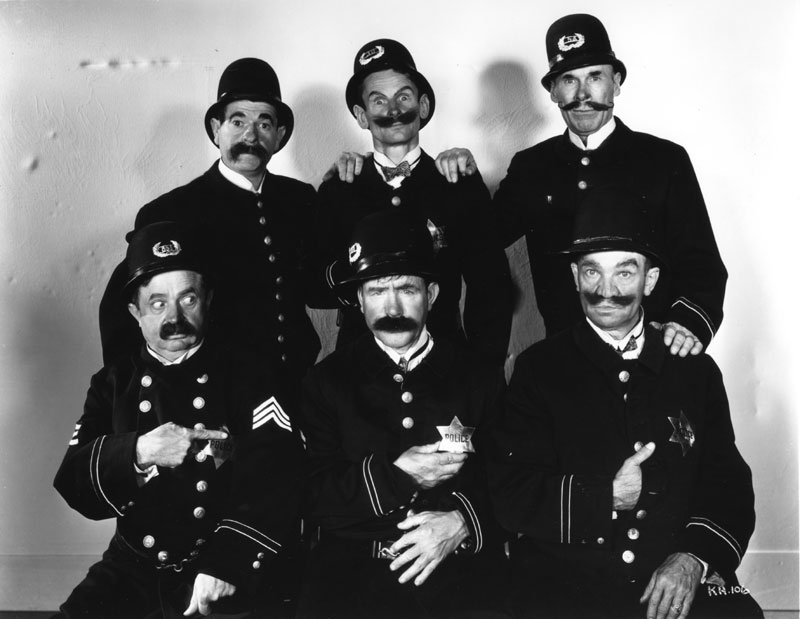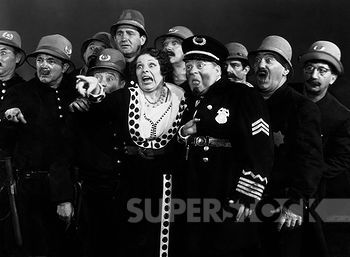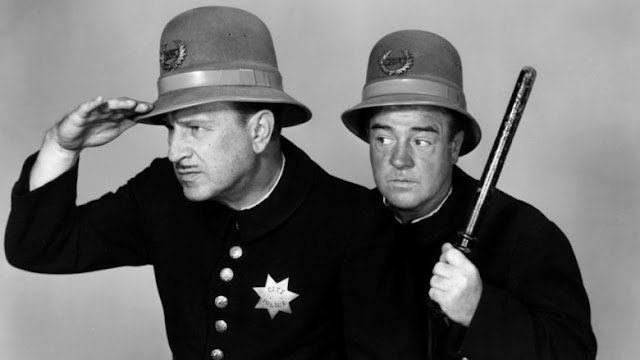Keystone Cops
From Wikipedia, the free encyclopedia

The Keystone Kops in a typical pose in The Gangsters (1913). The desk officer using the telephone is Ford Sterling. The policeman directly behind Sterling (in extreme background, left) is Edgar Kennedy. The hefty policeman at extreme right is Roscoe "Fatty" Arbuckle. The young constable with bulging eyes, fourth from right, is Arbuckle's nephew Al St. John. The casting of the Keystone police force changed from one film to the next; many of the individual members were per diem actors who remain unidentifiable.
As early as 1914, Sennet shifted the Keystone Kops from starring roles to background ensemble, in support of comedians like Charlie Chaplin and Fatty Arbuckle. The Keystone Kops serve as supporting players for Marie Dressler, Mabel Normand, and Chaplin in the first full-length Sennett comedy feature, Tillie's Punctured Romance (1914), as well as in Mabel's New Hero (1913) with Normand and Arbuckle, Making a Living (1914) with Chaplin in his first screen appearance (pre-Tramp), In the Clutches of the Gang (1914) with Normand, Arbuckle, and Al St. John, and Wished on Mabel (1915) with Arbuckle and Normand, among others. Comedian/actors Chester Conklin; Jimmy Finlayson; Ford Sterling and director Del Lord were also Keystone Kops.[citation needed]
In 2010, the previously lost short A Thief Catcher was rediscovered at an antique sale in Michigan. The short, filmed in 1914, stars Ford Sterling, Mack Swain, Edgar Kennedy, and Al St. John and includes a previously unknown cameo with Charlie Chaplin as a Keystone Kop.[1]
Original Line-up
The original Kops numbered only seven: George Jeske, Bobby Dunn, Mack Riley, Charles Avery, Slim Summerville, Edgar Kennedy, Hank Mann.[2]Revivals
Mack Sennett continued to use the Keystone Kops intermittently through the 1920s. By the time sound movies arrived, the Keystone Kops' popularity had waned. In 1935, director Ralph Staub staged a revival of the Sennett gang for his Warner Brothers short subject Keystone Hotel, featuring a re-creation of the Kops clutching at their hats, leaping in the air in surprise, running energetically in any direction, and taking extreme pratfalls. This footage has been used countless times in later productions purporting to use silent-era material.[citation needed][vague]The Staub version of the Keystone Kops became a template for later re-creations. 20th Century Fox's 1939 feature Hollywood Cavalcade had Buster Keaton in a Keystone chase scene. However, during his own silent film career, the nearest Keaton had appeared in a "police comedy" was The Goat (1921) and Cops (1922). Abbott and Costello Meet the Keystone Kops (1955) included a lengthy chase scene, showcasing a group of stuntmen dressed as Sennett's squad. (Two original Keystone Kops in this movie were Heinie Conklin as an elderly studio Guard; and Hank Mann as a prop man. Sennett also starred in a cameo role-as himself.) Mel Brooks directed a Keystone Kops-type car chase in his comedy film Silent Movie.
By the 1950s surviving silent movie comedians could be pressed into service as Keystone Kops regardless of whether they appeared with the troupe authentically.[vague] In the This Is Your Life TV tribute to Mack Sennett several Sennett alumni ran on stage dressed as Keystone Kops.[citation needed]
In popular culture
The term has since come to be used to criticize any group for its mistakes, particularly if the mistakes happened after a great deal of energy and activity, or if there was a lack of coordination among the members of the group. For example, the June 2004 election campaign of the Liberal Party of Canada was compared with "the Keystone Kops running around" by one of its parliamentary members, Carolyn Parrish.[3] In criticizing the Department of Homeland Security's response to Hurricane Katrina, Senator Joseph Lieberman claimed that emergency workers under DHS chief Michael Chertoff "ran around like Keystone Kops, uncertain about what they were supposed to do or uncertain how to do it".[4] Another example is a statement by Peter Beattie, Premier of the Australian state of Queensland, on the counter-terrorism investigation into Gold Coast doctor Mohamed Haneef in July 2007. After the Australian Federal Police committed a series of blunders, the Premier likened their actions to those of the "Keystone Kops".The Keystone Kops re-emerge every year in the town of Cedar Springs, Michigan during their Red Flannel Festival, and also in Sitka, Alaska during the annual Alaska Day festival.
The Police Academy movies that began in 1984 are frequently considered a modern day version of the Keystone Kops.[citation needed]
In sport, the term has come into common usage by television commentators, particularly in the United Kingdom and Ireland. The rugby commentator Liam Toland uses the term to describe a team's incompetent performance on the pitch. The phrase "Keystone cops defending" has become a favorite catchphrase for describing a situation in an English soccer match where a defensive error or a series of defensive errors leads to a goal.[5]
According to Dave Filoni, supervising director of the animated television series Star Wars: The Clone Wars, the look of the Police 'droid is based on the appearance of the Keystone Kops.[6]
Video games
In 1983, a video game called Keystone Kapers was released for the Atari 2600, 5200, and later Colecovision. Playing as Keystone Kop Officer Kelly, the player's objective is to stop would-be robber Hooligan Harry from escaping Southwick's Mall. The game, which became a hit, was produced by Activision; a similar later game, whose title features similar alliteration, is Bonanza Bros. (1990). The Keystone Kops also appear in the computer game NetHack, usually when the player steals from one of the shops. They are more dangerous than their cinematic inspiration, however; they typically surround the player's character, so escape is impossible, and then mercilessly beat the player with rubber hoses from all directions, while temporarily blinding the player with cream pie.See also
References
- ^ Trescott, Jaqueline (June 13, 2010). "The 'Thief' in festival's lineup is famous face, indeed: Chaplin's". Washington Post. p. E7.
- ^ Lahue, Kalton (1971); Mack Sennett's Keystone: The man, the myth and the comedies; New York: Barnes; ISBN 978-0-498-07461-5; p. 194
- ^ "CBC News Indepth: Canadian Government". Cbc.ca. http://www.cbc.ca/news/background/cdngovernment/parrish-carolyn.html. Retrieved 2009-09-26.
- ^ "Americas | Chertoff castigated over Katrina". BBC News. 2006-02-15. http://news.bbc.co.uk/2/hi/americas/4717916.stm. Retrieved 2009-09-26.
- ^ "The Angle of Post and Bar: The Art of Defending". Angleofpostandbar.blogspot.com. 2007-03-26. http://angleofpostandbar.blogspot.com/2007/03/art-of-defending.html. Retrieved 2009-09-26.
- ^ "Senate Murders Video Commentary". http://starwars.com/video/view/000984.html.
Further reading
- Basinger, Jeanine, (1999), chapter on Keystone Kops (also covers Mabel Normand) in Silent Stars, (ISBN 0-8195-6451-6).
- King, Rob (2008). The Keystone Film Company and the Emergence of Mass Culture. University of California Press. ISBN 0-520-25537-2.
External links
- Feature films
- Hoffmeyer's Legacy (1912)
- The Bangville Police (1913) with Mabel Normand
- The Gangsters (1913) with Roscoe Arbuckle, Ford Sterling, and Al St. John
- Barney Oldfield's Race for a Life (1913) with Mabel Normand
- Mabel's New Hero (1913) with Mabel Normand and Roscoe Arbuckle
- Making a Living (1914) (Available to watch/download from the Internet Archive) with Charles Chaplin
- Tillie's Punctured Romance (1914) (Available to watch/download from the Internet Archive) with Marie Dressler, Mabel Normand, and Charles Chaplin
- In the Clutches of the Gang (1914) with Roscoe Arbuckle, Mabel Normand, and Al St. John
- The Noise of Bombs (1914) with Edgar Kennedy as police chief
- Love, Loot and Crash (1915) (Available to watch/download from the Internet Archive) with Charley Chase
- Wished on Mabel (1915) with Roscoe Arbuckle and Mabel Normand
- Love, Speed and Thrills (1915) (Available to watch/download from the Internet Archive) with Mack Swain, Minta Durfee, and Chester Conklin
Mabel Norman, Charlie Chaplin, Marie Dressler, and Keystone Kop in TILLIE'S PUNCTURED ROMANCE.
The Stolen Jools
From Wikipedia, the free encyclopedia
| The Stolen Jools | |
|---|---|
| Directed by | William C. McGann |
| Produced by | Pat Casey |
| Starring | Wallace Beery Buster Keaton Edward G. Robinson Norma Shearer Joe E. Brown Laurel and Hardy Norma Shearer Joan Crawford Irene Dunne Loretta Young Fay Wray Gary Cooper Maurice Chevalier Wheeler and Woolsey |
| Distributed by | Paramount Pictures |
| Release date(s) |
|
| Running time | 20 minutes |
| Country | United States |
| Language | English |
The Stolen Jools (1931) is a short comedy film produced by the Masquers Club of Hollywood, featuring many cameo appearances by the film stars of the day. The stars appeared in the film, distributed by Paramount Pictures, to raise funds for the National Variety Artists Tuberculosis Sanitarium.
When the film was shown in theaters in 1931, a person would appear after the film to ask the audience for donations. Because the film was made for charity, it has an unusually large cast of actors from different studios, such as Warner Brothers, RKO Radio Pictures, Metro-Goldwyn-Mayer, Paramount Pictures, and Hal Roach Studios.
This film was known by the name The Slippery Pearls in the United Kingdom, and was thought to be a lost film until a print was found in the UK in the 1990s. Another print was later found in the US under the alternate title.
Plot
At the "Screen Stars Annual Ball" Norma Shearer has her jewels stolen. The police must find them and return them to her.
Cast, as listed in end credits
|
|
|
- (Uncredited)
See also
References
- ^ Transcribed from DVD: Best of Laurel & Hardy, Volumes 2-3, Brentwood Home Video, 2004
External links
Wallace Beery at the police station. Wallace Beery had worked for Mack Sennett, but not as a Keystone Kop.
Buster Keaton at the police station. Buster Keaton hadn't worked for Mack Sennet in the silent era, but this wasn't the last time he'd be associated with the Keystone Kops.
Laurel and Hardy represent the forces of law and order in this story, for some reason.
The Our Gang Kids also put in an appearance.
As do Warner Baxter and Fifi D'Orsay.
MICKEY'S GALA PREMIERE, 1933
MICKEY'S GALA PREMIERE, 1933. By the time this cartoon came out, the old Keystone Kops comedies were already history. Ben Turpin, Mack Swain, Harry Langdon and Chester Conklin had all worked for Mack Sennett, but not as Keystone Kops. But Ford Sterling had been a Keystone Kop before, and he would be one again.
KEYSTONE HOTEL. 1935
Keystone Hotel Kops
Keystone Hotel (film)
From Wikipedia, the free encyclopedia
| Keystone Hotel | |
|---|---|
| Directed by | Ralph Staub |
| Written by | Joe Traub |
| Distributed by | Warner Brothers |
| Release date(s) | 21 September 1935 |
| Running time | 20 minutes |
| Country | United States |
| Language | English |
Plot
The story follows the arrival of the cross-eyed Count Drewa Blank (Ben Turpin) at a downtown hotel, to judge a beauty contest. While downstairs various parties try to sway the Count's decision, the house detective investigates shenanigans upstairs, some involving a vibrating exercise machine. The Count's mistaken choice of the winner leads to a thrown pie, then a general pie fight, then the summoning of the Keystone Kops.Cast
- Ford Sterling
- Ben Turpin
- Chester Conklin
- Hank Mann
- Marie Prevost
- Vivien Oakland
- Dewey Robinson
- The Keystone Kops
External links
Producer Ralph Staub, center, with cast.
Marie Prevost, Ben Turpin, Ford Sterling, and Hank Mann
This film of course features pie throwing.
HOLLYWOOD CAVALCADE, 1939.
Hollywood Cavalcade
From Wikipedia, the free encyclopedia
| Hollywood Cavalcade | |
|---|---|
| Directed by | Irving Cummings Malcolm St. Clair (silent sequences) Buster Keaton (uncredited) |
| Produced by | Darryl F. Zanuck |
| Distributed by | 20th Century Fox |
| Release date(s) | 13 October 1939 |
| Running time | 97 min. |
| Country | United States |
| Language | English |
Atypical for Faye's 20th Century Fox output, this has no musical numbers, and the tone is more dramatic than comic. (The alternate title was "Falling Stars".) The first part of the film provides a significant look, fictionalized but still valuable, at silent-era performers and their productions.
Cast
- Alice Faye as Molly Adair Hayden
- Don Ameche as Mike Connors
- J. Edward Bromberg as Dave Spingold
- Alan Curtis as Nicky Hayden
- Stuart Erwin as Mike's Cameraman
- Jed Prouty as Keystone Cop Police Chief
- Buster Keaton as Himself
- Donald Meek as Studio Chief
- George Givot as An Englishman in the Show
- Al Jolson as Himself
- Eddie Collins as Keystone Cop
- Mack Sennett as Himself
- Ben Turpin as Bartender in Western
- Chester Conklin as Sheriff in Western
- Hank Mann as Keystone Cop
- Snub Pollard as Keystone Cop
- James Finlayson as Himself
External links

1939 NEW YORK WORLD'S FAIR
Ann Pennington was a featured dancer at the 1939 New York World's Fair, appearing regularly as part of "George Jessel's Old New York" exhibition at the Fair's amusement area. Keystone Kops appeared with her as part of the act.
Here we see a photo of Ann Pennington from this period. A video of her act is embedded at the bottom of the page.
ABBOTT AND COSTELLO MEET THE KEYSTONE KOPS, 1955
Abbott and Costello Meet the Keystone Kops
From Wikipedia, the free en
| Abbott and Costello Meet the Keystone Kops | |
|---|---|
 Theatrical release poster | |
| Directed by | Charles Lamont |
| Produced by | Hoawrd Christie |
| Written by | John Grant Lee Loeb |
| Starring | Bud Abbott Lou Costello Fred Clark Mack Sennett Joe Besser |
| Music by | Joseph Gershenson |
| Editing by | Edward Curtiss |
| Distributed by | Universal Pictures |
| Release date(s) | January 31, 1955 |
| Running time | 78 min. |
| Language | English |
| Budget | $743,000 |
After the film was completed, Universal wanted to rename it Abbott and Costello in the Stunt Men, because they did not consider the "Keystone Kops" to be relevant anymore. However, in October, 1954, the studio relented and agreed to use the "Keystone Kops" name.[1]
Plot
Harry Pierce (Bud Abbott) and his friend, Willie Piper (Lou Costello), invest $5,000 in a motion picture studio. They are sold a deed to the Edison Studio by a con man, Joe Gorman (Fred Clark), who immediately leaves town with his girlfriend, Leota Van Cleef (Lynn Bari). The couple heads to Hollywood where he poses as a European director, Sergei Toumanoff, who plans to make a film starring Leota. Meanwhile, Harry and Willie pursue Gorman across the country in hopes of getting their money back after learning that the deed they purchased is worthless. They hop off a freight train near Los Angeles and stumble onto the set of the western film that Toumanoff happens to be directing. He is furious with the interruption, but the head of the movie studio, Mr. Snavely (Frank Wilcox), hires Harry and Willie because he is impressed with their "stunt work".Toumanoff plots to dispose of Harry and Willie before they can learn his true identity, and he arranges for Willie to double for Leota during a dangerous airplane stunt. His cohort, Hinds (Maxie Rosenbloom), sabotages their parachute and arranges for live bullets to be fired from the other plane in the scene, but Harry and Willie manage to avoid harm. After viewing the film of the airplane stunt, Snavely decides that Harry and Willie would make a great comedy team, and assigns a visibly annoyed Toumanoff to direct them in a film. (Snavely is aware that Toumanoff is actually Gorman, and has arranged for everyone that has been swindled to get their money back if Toumanoff agrees, which he does). Gorman and Leota then go about robbing the studio safe of $75,000, but are discovered by Harry and Willie, who give chase. The studio's Keystone Kops are asked by Harry and Willie, who believe that they are real policemen, to assist in the chase. The Kops decide to play along, believing that they are on the same work team. The chase progresses onto the city streets before ending at an airport where the swindlers are finally captured. Unfortunately, the stolen money is blown away by the wind generated by the airplane's propeller.
Production
| This unreferenced section requires citations to ensure verifiability. |
DVD releases
This film was released twice on DVD, on The Best of Abbott and Costello Volume Four, on October 4, 2005[2], and again on October 28, 2008[3] as part of Abbott and Costello: The Complete Universal Pictures Collection.References
- ^ Furmanek, Bob and Ron Palumbo (1991). Abbott and Costello in Hollywood. New York: Perigee Books. ISBN 0-399-51605-0
- ^ http://www.amazon.com/dp/B000A1INIA
- ^ http://www.amazon.com/dp/B001EXE2Y2
External links
THE KEYSTONE KOPS RIDE AGAIN
LIFE photo with stars of the day posing as the Keystone Kops and Bathing Beauties.
In UPA's 1961 television cartoon series THE DICK TRACY SHOW, Keystone Kop characters called "The Retouchables" helped Dick Tracy fight villians from the comics such as Flattop, Mumbles, and The Brow.
In 1962, former Keyystone Kop Eddie LeVeque purchased the rights to the Keystone Kops name from the Sennett estate and was able to revive the classic comedy act.
LeVeque explained his acquisition in a 1970 article written for Hollywood Studio Magazine:
In Mack Sennett’s last will and testament there is no mention of the Keystone Kops or the name Keystone, nor when the will was probated shortly after he died. In fact, there is no paper or document in existence stating Mack Sennett retained an interest in Keystone.
Sennett sold all his interest in Keystone to the Triangle-Keystone people in June of 1917. He started producing movies under his own name, Mack Sennett Comedies which were first released by Paramount.
When Triangle-Keystone went out of business, the name was all but forgotten until I re-copyrighted the name with the idea of keeping it active. In fact I have more than complied with the requirements which the law demands.
Buster Keaton on stage with Eddie and the Keystone Kops at the Movieland Wax Museum, May 3, 1964.
( Reblogged from http://www.thewritingdisorder.com/nonfiction2leveque.html )
The encroachment of age would eventually end the career of the last of the Keystone Kops, but there was still room in the world for a few new ones..
EIGHT MEN OUT, 1988. Here I am with two other guys that were in the movie, everybody called them the Keystone Kops.
Watch THE STOLEN JEWELS:
KEYSTONE HOTEL
Ann Pennington at the 1939 New York World's Fair, where she appeared with Keystone Kops.
Abbott and Costello:
http://www.abbottandcostello.net/
Ann Pennington:
http://vitaphone.blogspot.com/2006/12/divertimento.html
http://www.goldensilents.com/comedy/benturpin.html
http://www.thewritingdisorder.com/nonfictionleveque.html
Eddie Levequet, last Keystone Kop pt II:
http://www.thewritingdisorder.com/nonfiction2leveque.html
http://www.movie-index.com/film-reviews-hollywood-cavalcade-1939
HOLLYWOOD CAVALCADE:
http://www.coffeecoffeeandmorecoffee.com/archives/2008/10/hollywood_caval.html
KEYSTONE HOTEL:
http://www.silentcomedians.com/forum/viewtopic.php?t=178
http://www.silentcomedians.com/forum/viewtopic.php?p=3275&sid=a6430139d12e8ebb3dae7b2a39beae66
Laurel and Hardy:
http://www.laurel-and-hardy.com/
Mack Sennett Blogspot:
http://macksennett.blogspot.com/
















580x876.jpg)




_01.jpg)



















